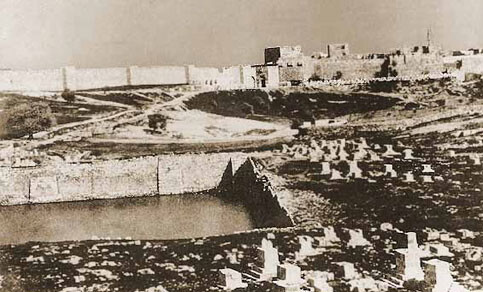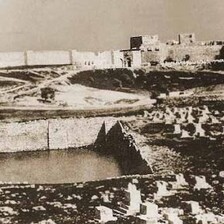The Electronic Intifada 22 February 2010

The Mamilla cemetery in Jerusalem, 1854. (Wikipedia)
I carried a handful of ashes from my father’s cremates into the Occupied Palestinian Territories a few years ago, hoping to take them to his hometown, Nablus. At the border, the only available taxi was driven by an Israeli Moroccan Jew. Delighted I was an Arab, he immediately plunged into conversation and pointed out various landmarks along the way to Jerusalem.
“That road,” he said at one point, “leads to Nablus,” indicating the tarmac cutting through the rocky soil as we drove through a desolate area. I asked him to stop the car. Israel often kept Nablus under curfew for weeks on end and I didn’t know if I’d be able to get there during my short trip. On the road to Nablus, I laid the ashes and paid my respects. Back in the car, the puzzled driver wondered what I had been doing. When I told him he asked hesitantly, “Don’t you have rites like ours, including visiting loved ones’ graves?”
I stared at the back of his neck, as brown as my own, as I sought a response. We do have similar rites. It is rare for a Muslim to seek cremation, as in our father’s case, part of the enforced modernity of exile. In fact, at no time is the loss of Palestine more piercing than at a loved one’s passing, reinforcing the realization that, Muslim or Christian, Palestinians are as scattered across the globe in death as in life. But how could one explain 100 years of history in a cab ride? “Yes, but you’ve made it impossible for us to practice ours.”
So it is with special poignancy that I have followed the latest twist in the battle over Jerusalem’s Mamilla Cemetery, a Muslim cemetery known in Arabic as Maman Allah, where the US-based Simon Wiesenthal Center intends to build a Museum of Tolerance, a project stalled by legal and other protests since it began in 2004.
Mamilla is estimated to be over 800 years old and was in continuous use until 1948 when the Western part of Jerusalem was conquered as Israel was created. In the latest Palestinian challenge, representatives of 60 of the oldest and most prominent Jerusalemite families have petitioned several bodies at the United Nations to uphold the international legal obligation to halt the project.
The battle over Mamilla encapsulates many aspects of Israel’s approach to Palestinian rights since the conflict began, and it is worth considering five here.
First, the use of legal garb to shroud illegal acts. In this case, for example, Israel’s high court ruled in favor of the museum project in 2008. However, it turned out that the Israeli Antiquities Authority had withheld its own Chief Excavator’s conclusion that the site should not be approved for construction. Calling the Authority’s conduct an “archeological crime” the Chief Excavator noted, among other things, at least four unexcavated layers of Muslim graves dating back to the 11th century. However, the court has refused to reopen the case.
Second, the overreach. The move on Mamilla spotlights not just Israel’s occupation of Arab East Jerusalem in 1967, but also its original takeover of West Jerusalem. The international community still does not accept Israeli sovereignty over West Jerusalem because the basis for the establishment of the Israeli state — the 1947 United Nations partition plan — provides for a corpus separatum for Jerusalem, as the European Community reminded Israel in 1999.
Third, the ongoing creation of facts on the ground to erase evidence of the indigenous inhabitants. As former Israeli leader Moshe Dayan told Technion University students back in 1969, “There is not one place built in this country that did not have a former Arab population.”
Fourth, the Orwellian use of language to mean the direct opposite of what is intended: for example “tolerance” for “discrimination.” Indeed, the plans for the Museum of Tolerance are replete with irony. At one point, it was suggested that a horizontal barrier be built to separate the museum and the graves to show “respect” — a horizontal separation of the dead comparable to Israel’s vertical separation barriers in the West Bank and Gaza.
Fifth, the delegitimization — not of Israel, which is a secure member state of the UN — but of the Zionist ideology that resulted in Israel’s creation. These actions remind the world that one people was displaced by another. The project architect, the renowned Frank Gehry, has since withdrawn his plans. Further international attention to the Mamilla case can only add to the growing global campaign to boycott Israel until it upholds international law.
Mamilla is not just about family history but also a nation’s history, as Dyala Husseini-Dajani — who comes from one long-established Jerusalem families and married into another — told a journalist while at the cemetery to say a prayer to her forebears. She added, “One day I want to be buried here. And I want my grandchildren to come and say this prayer for me.” As I read those words, I wished the Moroccan Jewish taxi driver would read them too.
Nadia Hijab is an independent analyst and a senior fellow at the Institute for Palestine Studies. This column was syndicated on 16 February 2010 by Agence Global.




